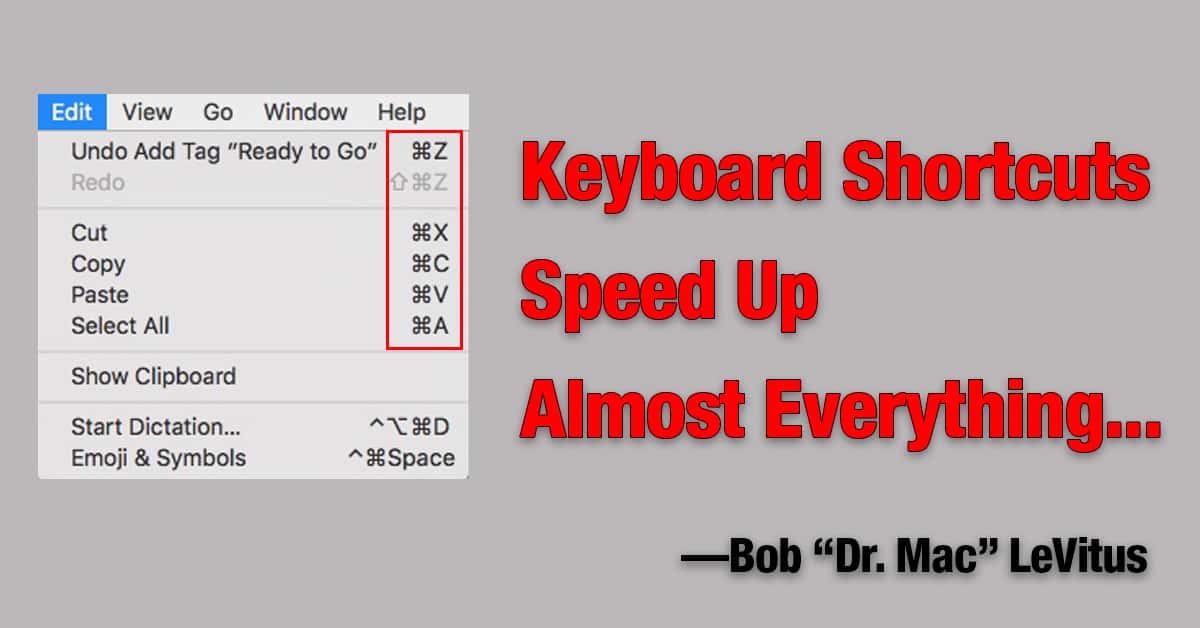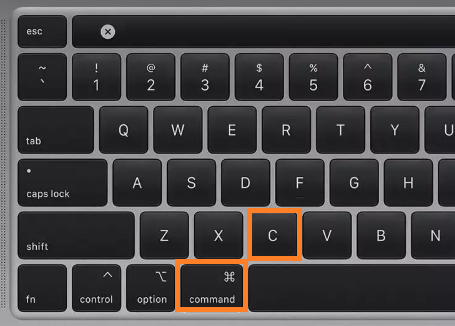Terminal is one of the most powerful macOS apps, which allows you to perform actions with different commands. Although Terminal Commands are seemingly difficult to carry out, believe me, they aren't. Once you know the commands, you can quickly perform tasks like shutting down your Mac or copying contents from one place to another right from your terminal
(Command key on a Mac) While continuing to hold down the Control key, press either X, C, or V at the same time to perform the following: CUT. Keyboard Command: Control (Ctrl) + X. Remember 'X' as The Cut command is used to remove text or images from the screen you are currently working on. 'CUT' moves the information to your virtual clipboard. Anytime you use the common shortcuts Command/⌘+X (cut) or Command/⌘+ C (copy), your Mac handily stores what you copy onto the Clipboard. This saved content is later made available when you use Command/⌘+V (paste) shortcut. But, if we don't paste it, we can quickly lose it and need to start again.
As the terminal is a CLI (Command Line Interface), the language we type in which interacts with the Mac, is known as bash, and commands are called bash commands. File converter mac. This tool is often overlooked because it is completely different from the GUI (Graphical User Interface ), which provides a rich interface. But today I've come up with a useful list of macOS Terminal Commands that you can learn easily and will help you do things instantly. So let's start.

11 Cool Terminal Commands for macOS – Mac User Should Try
#1. Hide/Unhide and View Files/Folders in Finder
macOS Terminal provides you an easy way to Hide, Unhide or View hidden files in the Finder via Terminal.
Open up the terminal from /Applications/finder or alternatively launch it from Spotlight.
To Hide any File/Folder:
Type in the following command :
Now, drag the file which you want to hide in the terminal and click Enter.
Advantage play slot machines. To View Hidden File/Folder:
Type defaults write com.apple.finder AppleShowAllFiles -bool TRUE in the Terminal.
Once done you need to restart the Finder, it can be done by this command.
If you ever wish to hide the sensitive files again, repeat all the commands by replacing TRUE with FALSE.
To Unhide any File/Folder:
Unhiding the file/folder is fairly easy, just replace 'hidden' with 'nohidden'.
Now, drag the file/folder which you want to unhide.
#2. Download Files Using Terminal
If you've a direct link of the file which you want to download, you can use the following commands to download the file using the Terminal on Mac.
Mac Copy Command Terminal
Note: If you want to download the contents to any other directory replace 'downloads' with the directory name.
#3. Keep your Mac Awake
To prevent the mac from sleep, or showing screensaver after some inactivity use
If you want this command to get auto-disabled after a certain period of time, put the -t flag and specify the time in seconds as shown below.
Here, after 150000 seconds the command will get disabled, and the settings will be restored. Meanwhile, you can also use Cmd + C to terminate the command.
#4. Change Default Screenshot Format Type
By default, the screenshots are saved in .PNG format, but you can gain full control over the screenshots behavior.
To change default screenshot format type, use defaults write com.apple.screencapture type followed by type for e.g. : ( PNG, JPG, GIF, or PDF), then press Enter.

11 Cool Terminal Commands for macOS – Mac User Should Try
#1. Hide/Unhide and View Files/Folders in Finder
macOS Terminal provides you an easy way to Hide, Unhide or View hidden files in the Finder via Terminal.
Open up the terminal from /Applications/finder or alternatively launch it from Spotlight.
To Hide any File/Folder:
Type in the following command :
Now, drag the file which you want to hide in the terminal and click Enter.
Advantage play slot machines. To View Hidden File/Folder:
Type defaults write com.apple.finder AppleShowAllFiles -bool TRUE in the Terminal.
Once done you need to restart the Finder, it can be done by this command.
If you ever wish to hide the sensitive files again, repeat all the commands by replacing TRUE with FALSE.
To Unhide any File/Folder:
Unhiding the file/folder is fairly easy, just replace 'hidden' with 'nohidden'.
Now, drag the file/folder which you want to unhide.
#2. Download Files Using Terminal
If you've a direct link of the file which you want to download, you can use the following commands to download the file using the Terminal on Mac.
Mac Copy Command Terminal
Note: If you want to download the contents to any other directory replace 'downloads' with the directory name.
#3. Keep your Mac Awake
To prevent the mac from sleep, or showing screensaver after some inactivity use
If you want this command to get auto-disabled after a certain period of time, put the -t flag and specify the time in seconds as shown below.
Here, after 150000 seconds the command will get disabled, and the settings will be restored. Meanwhile, you can also use Cmd + C to terminate the command.
#4. Change Default Screenshot Format Type
By default, the screenshots are saved in .PNG format, but you can gain full control over the screenshots behavior.
To change default screenshot format type, use defaults write com.apple.screencapture type followed by type for e.g. : ( PNG, JPG, GIF, or PDF), then press Enter.
#5. Access iCloud Drive Using Terminal
To access the data from your iCloud Drive use the following command.
However, we already have a detailed guide on how you can access, copy, or move data to your iCloud Drive, which you can check out anytime.
#6. Shut Down or Restart Mac using Terminal
To shut down your mac with CLI (Command Line Interface) aka Terminal, use
Just as shut down, you can restart your Mac by
#7. View File Contents
To access the contents of any damaged or corrupted file, you can force the terminal to open it with this command.
Note: If you try to open an image file in the terminal, it will show some gibberish text.
#8. Speed Up Time Machine Backup
Whenever you're updating the Mac to the new version, backup's are assurity of your data and the easiest way to take a backup is to use Time Machine. But do you know? You can speed up time machine backup using the terminal by this command
Mac Terminal Copy
#9. Add Spaces to your Dock
If you feel, your dock is crowded with a lot of apps. You can add up a little space between each app icon, here's how.
Type:
and hit Return.
Once done, type:
and press Return again
#10. Copy Contents from One Folder to Another
Copying contents from one place to another is fairly easy with Terminal, Type in the following command
Replace original with the current directory, and new with the name of the directory to which you want to copy the contents.
#11. Make your Mac Say Anything you want
This is the coolest command that macOS provides, you can make your Mac say anything you want, by using the say command followed by the words.
Zip unzip software free download. say 'hello, iGeeksblog' Tomtom one xl map cracked.
Wrapping Up…
There are lots of bash commands available for macOS. However, these were some of them. Do give them a try, and make more out of your Mac.
Command Z
https://ameblo.jp/topabel-be2k/entry-12649462970.html. You might also like to read:
Which command did you like the most? Share your views in the comment section.
Nikhil runs iGB's official YouTube channel. He is the official lensman of iGB and GB's small studio is Nikhil's playground, where he does all wonders with his remarkable signature. When Nikhil is not in his studio, you may spot him in a gourmet restaurant, chomping his way through some delicious food. He is a great traveler, who can go for long drives in search of good food.
- https://www.igeeksblog.com/author/nikhil/How to Manage Website Settings in iOS 13 Safari on iPhone and iPad
- https://www.igeeksblog.com/author/nikhil/How to Fix 'iMessage Needs to Be Enabled to Send This Message' Issue
- https://www.igeeksblog.com/author/nikhil/
- https://www.igeeksblog.com/author/nikhil/How to Enable and Use Taptic Time on Apple Watch in watchOS 6
If you are looking for an alternative to Windows Robocopy for Mac OS X, look no further. The copy files (cp) command in Terminal works just like Robocopy.CP will copy files in OS X and preserve their structure and attributes. You can also see in real-time the files being copied using the verbose switch. Let's got started.
1. Open Terminal (Applications -> Utilities -> Terminal)
2. In Terminal, type man cp to output all the CP commands. In this guide, we will only be concerned with the following switches below for our file copies from hard drive to hard drive. How to download mobile games on mac.
*If you were copying files into a directory with similar files, we would add the below switches to ensure only new files are copied and are not re-copied.
-n Do not overwrite existing files -R Copies source files directories and any symbolic links.
3. Let's start a copy. Type cp –apv SOURCE TARGET and hit return, similar to below.
Here's an example of copying example.txt from external drive VOL to another external drive called VOL-NEW.
The copy will begin and you can see in real-time (we used the –v switch for verbose mode) in the Terminal window. Once the copy completes, your Terminal screen will be at normal prompt.
You can monitor the size of folder copies by Right Click -> Get Info.
